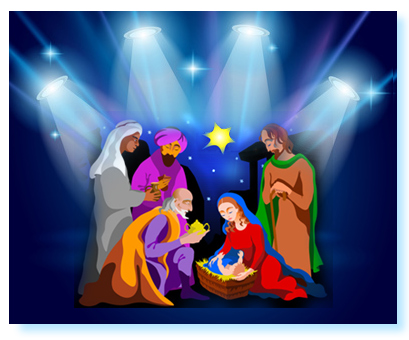of the shepherds who followed a shining star, perhaps because they identified it with their own legend in which a great comet announced the end of one empire and the birth of a new one, but above all, because when they rendered “adoration” to the Christ Child, the actors playing the shepherds introduced their own prehispanic dances that concluded in a mitote with leaps of joy
The first formal record of the pastorela we know of dates from 1536. It is called “El Auto de Adoración de los Reyes Magos’ (The Adoration of the Three Kings). Written in Nahuatl, dancing and music were added to it. It had thirteen actors: the Baby Jesus, the Virgin Mary, Saint Joseph, The Three Kings, their messenger, an angel, King Herod, his chief steward, and three Jewish priests.
As you might imagine, the shepherds, secondary characters in the bible story, in this setting where they danced and kibbitzed about, soon became the main actors. Each shepherd took on a personality, like Gila, the group leader, and Bato or Bartholomew, the ignorant, scatter-brained fellow who serves to explain the religious message to the public.
The time arrived when owing to its major element of jocularity and even mischief-making, the pastorelawas no longer allowed in the churches, not even in the atriums, and it had to take to the streets. Freed of restraints, it acquired the language of the common folk, spontaneous situations, and a certain element of irony in connection with the government of New Spain.
These “irreverent stances” did not please the Holy Inquisition, an iron-handed institution that checked up on the proper behaviour of Catholics in the Spanish territories, and so it was that they were declared irreligious and their staging prohibited.
Then, in the 19th century, Mexicans, particularly those living in the country’s capital, entertained an immoderate admiration for all things foreign, mainly from France. As a consequence, the pastorelaswere relegated to towns and settlements far from this international influence.
Mexican intellectuals would not take long to rescue them from hiding however, to make them shine now not in the atriums or public plazas, but in Mexico’s brightest theater. “La noche más venturosa”, written in 1821 by José Joaquín Fernández de Lizardi, marks this new epoch for the pastorela and casts it solidly among the most famous, deep-rooted traditions of Mexico.
Today, pastorelas are very different. Very rarely do the personages of Jesus, Mary or The three Kings appear in them. The shepherds may be a band of street urchins or rural workers from the North, and there is a huge variety of settings; besides the jocular language, the content may be highly sexual or even vulgar.
Nonetheless, the basic theme continues to be the struggle between Good and Evil, with the outcome always favouring Good. And although the message is not solely Catholic, it is evangelical in that it brings good news and is a time for renewal. Implicitly, it carries a collective desire to start over and to imbue all of society with good intentions.
The pastorelas of today are laced with political irony, mockery, or at least funny allusions to public figures, and a strong dose of the typically Mexican double-entendre that we call the ‘albur’. Without this non-exportable ingredient, the pastorela would be somewhat like a taco minus the salsa.
There are two locations, like the Atrio of Cuernavaca, and the El Carmen Museum in Mexico City, among others, where the tradition of a pastorela with the original personages is preserved, with the colors of the piñatas and the lanterns, and that end with a delicious hot punch to ward off the cold of winter nights. This is something that every Mexican girl and boy experiences and continues to nourish with poignant affection throughout his or her life.
Angelica Galicia


